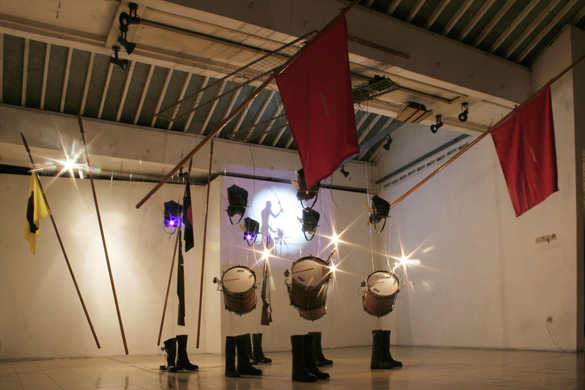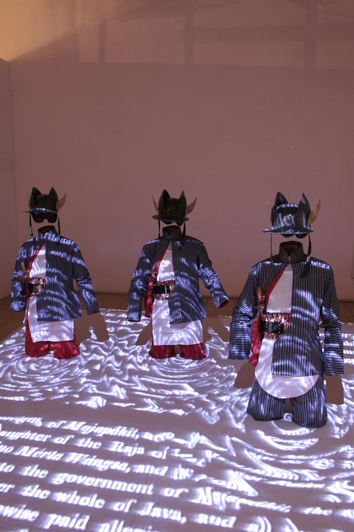


War of Java, Do You Remember? #1
Jompet Kuswidananto
Java’s Machine: Phantasmagoria
Cemeti Art House
15 Dec – 18 Jan 2009
Lining up against the entrance corridor into the main exhibition space at Cemeti Art House, Yogyakarta, last December is an armed unit of five invisible standing figures, suggested through a skeletal furnishing of their martial disposition by the uniformity of their red helmets, strapped-on rifles and firmly planted boots. They allude to the ‘Lombok Chilli’, royal guards of the Yogya Sultanate who still plays a ceremonial role today, that protects, above all, a distinct sense of pride in the Javanese identity they represent.
At their centre hang, in mid-air, speakers located in proximity to the heart region of these invisible men that contrapuntally compete to convey an interminable lists of historical facts in Indonesian, English and Javanese – producing a messy chorus that disrupts the possibility of a coherent narrative, pressing a surfeit of information onto an unexpected public as well as indicting the audience’s failure to grasp its immensity, just as it proposes the incommensurability of any sense of total understanding in this ambitious undertaking.
This work (War of Java, Do You Remember?#1) sets the tone for Kuswidananto a.k.a. Jompet’s powerful and subtle exploration on the terms in which the colonial history of Java are confronted today. The phantasmagoria, a modified magic lantern invented in late 18th century France that projected moving images of ghoulish subjects as entertainment to a popular audience, is a fitting title that describes the hallucinatory and haunting battalion that populated Jompet’s installation.
Animated by rather primitive and by-and-large anachronistic technological computation, these automatons may seem dumb and antiquated, but the spook effect is largely derived from their mindless and almost irrational shoring of the past into the present, a kind of return of the repress, and one with a violent comeback.
In War of Java, Do You Remember? #3, a parading ghost army drums to the shadowy dance of an unidentified figure projected onto the far end wall. Each lash of a cloth whip towards the video camera produces a shift in the percussionists’ rhythm. Piercing flags stick out in all direction, suggesting an inevitable march, a movement that is crucially tempo-ed to the spectral dancer’s whip.

War of Java, Do You Remember? #3
This wayang-like orchestration could very well fit into the prevalent reading of Jompet’s practice as an examination of the notion of Javanese syncretism. The artist himself observes, ‘Instead of opposing any incoming culture and religion, the Javanese were thought to have taken everything as necessary ingredients to form a new synthesis: a basic Javanese syncretism… Syncretism then happened to be a strategy, a system, in an attempt to reconcile, to manipulate, or to overcome disparate or contradictory beliefs; between the ‘old’ and the ‘new’, the ‘genuine’ and the ‘alien’, the ‘traditional’ and the ‘modern’, between ‘us’ and the ‘other’.’
The video War of Java, Do You Remember? #2 shows a figure performing a ritualised dance in a factory environment surrounded by colossal machines. It illustrates the intersection between two different knowledge systems, revealing their awkward synchronicity.
When the Dutch first introduced farming machines, sugar farmers invented a new ritual, called Cembegan, as a means through which the industrial machine is made comprehensible within the Javanese cosmology and belief. Agung Hujatnikajennong notes in the exhibition essay that this syncretic process created ‘a unique juxtaposition between the magical and mechanical’.
More importantly, this return of history as a phantasmic host that wields military might hints at the violent and vindictive ambition of history as a form of moral authenticity.
War of Java, Do You Remember? #5 took place as a performance on the opening night and was later displayed throughout the exhibition in the form of a video recording showing a nondescript Javanese man stripped to his underwear facing an invisible jury of indicting voices that prosecute him for his failure to remember. Questions were hurled against his cowering body as he stammered and foundered from his inability to recall events that happened throughout Dutch rule Indonesia.

War of Java, Do You Remember? #5
This archetypal clown of the commonplace everyday man is charged for the criminal act of forgetting. Yet, his body – palpable, and alive – is a stark contrast the absent bodies of the faceless, dour yet exquisite corps who could only contained within themselves a ceremony of words, a garble of information, beholden to a moral duty that is holier-than-thou.
To have been able to address the complexity of history’s weight, how stifling it can be and the irresolution between the need to face history by the day and the desire to move on is in my opinion the strength of this exhibition.
The war of Java is no longer the historical war that happened in the past but the culture war waged in the present between a society that has hopped onto the vectors of globalisation, a fast machine towards a future, and the weighty baggage, the cultural history, that refuses to compromise or forgive an increasingly amnesiac generation that wants no lessons from the stream of letters that shored against the lonely sodden soldiers steeped in a watery pool of text in War of Java, Do You Remember? #4, plucked from Thomas Stanford Raffles’ seminal work, The History of Java.

War of Java, Do You Remember? #4
It is of course out of desperation and frustration rather than outrage that this spooky regiment returns to haunt. Like the spectre appearing to Hamlet, it seeks to address a time that is ‘out of joint’, of what it perceives to be a disturbing failure of our recent ability to remember.
The phantasmagoria is not merely a reminder; it is a moral injunction. Yet, like all injunctions, its single-minded pursuit might come across as brutally sanctimonious at times. The eerie tableau offered by Jompet succeeds because it is more than a historical diorama of the past; it delivers a sophisticated reflection on the present culture war, the value of its historiography and its implication on our lives.
(SS)
Sorry, the comment form is closed at this time.
Jompet had one of these at the Jakarta Biennale! it was great! the sound were all carefully orchestrated with the successful use of simple motors and gears! very nice to see installations like these ‘work’! Kudos to his technical team!
Here’s something semi-related to the culture “war” which can be considered as a clear ‘WIN’ in terms of public opinion.
Anime is Japan’s favorite form of wayang-kulit and Studio Ghibli keeps making these hits that enter into the nipponese mass consciousness so quickly and so strongly that (imported) traditional cultural practices will open its tight ass for it
http://www.youtube.com/watch?v=hVedc-xB2YE
Vincent: haha ya, i saw pics of Jompet in the Jakarta Biennale from RogueArt’s blog… his works are quite amazing huh, and especially eerie since his ‘primitive’ motors give such an antiquated feel to his figures. I’m afraid of them! :/
Daniel: ya i think they did something on video game symphony at the MPO recently. Dunno how successful these things are la or whether the win is justified. In the case of video game music, I rather listen to crystal castle’s remixes in a lap sap party for example :)